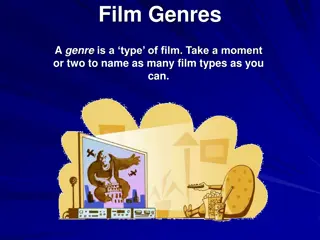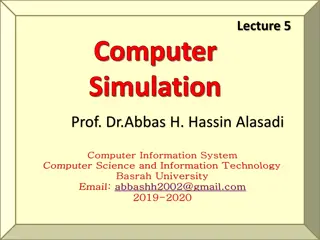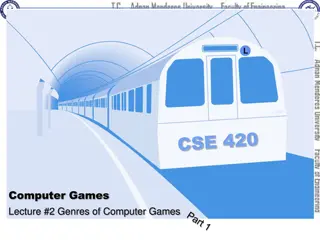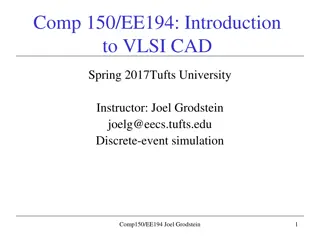Genres of Computer Games: Vehicle Simulation and More
Exploring the diverse world of computer games, this lecture delves into various genres such as vehicle simulation, construction and management, adventure games, and artificial life simulations. Learn about designing game worlds, creating artificial opponents, and different gameplay mechanics. Understand the nuances between military and civilian flight simulations, as well as the core mechanics of economies and management. Dive into the importance of character and story in adventure games, and discover the steps to designing puzzle games. Uncover the different forms of artificial life simulations and explore the player's needs for puzzle games.
Download Presentation

Please find below an Image/Link to download the presentation.
The content on the website is provided AS IS for your information and personal use only. It may not be sold, licensed, or shared on other websites without obtaining consent from the author.If you encounter any issues during the download, it is possible that the publisher has removed the file from their server.
You are allowed to download the files provided on this website for personal or commercial use, subject to the condition that they are used lawfully. All files are the property of their respective owners.
The content on the website is provided AS IS for your information and personal use only. It may not be sold, licensed, or shared on other websites without obtaining consent from the author.
E N D
Presentation Transcript
L Computer Games Lecture #2 Genres of Computer Games
Objectives Know the different types of vehicle simulation games Know how the design of the game world influences the player s perception of speed Know some ways to design artificial opponents for the game Lecture #2 Genres of Comp. Games 2
Objectives (Cont.) Understand the distinctions between military and civilian flight simulations Be familiar with the various views often used in vehicle simulation interfaces Lecture #2 Genres of Comp. Games 3
Objectives (Cont.) Know the definition of a construction and management simulation Know the differences between plan-and-build and purchase-and-place gameplay mechanics Know the basic gameplay modes and artificial behaviors common to this genre Lecture #2 Genres of Comp. Games 4
Objectives (Cont.) Understand the issues facing a designer for user interface for this genre Understand the core mechanics of economies, construction, and management Lecture #2 Genres of Comp. Games 5
Objectives (Cont.) Know the definition of an adventure game and the common game features of the genre Understand the importance of character and story in the genre Describe the different interaction models and perspectives common to adventure games Understand how to use puzzles and inventory in designing an adventure game Lecture #2 Genres of Comp. Games 6
Objectives (Cont.) Know the different forms of artificial life games and simulations Design basic artificial life systems Know the steps to designing puzzle games Understand the player s needs for puzzle games Lecture #2 Genres of Comp. Games 7
What Are Vehicle Simulations? Feels like driving, flying, or controlling a vehicle Simulations vary from realistically handling the vehicle to adding game mechanics such as combat, racing, and special challenges Space and water vehicle simulations follow the same fundamental features as flying and driving simulations Lecture #2 Genres of Comp. Games 8
Game Features Flight simulators Civilian flight simulators are realistic and don t include combat Military flight simulators are simplified but provide tactical conflict as well as physical challenges Driving simulators Organized racing is driving in an existing racing class; requires licensing Imaginary racing uses imaginary situations Lecture #2 Genres of Comp. Games 9
Game Features (Cont.) Players Purists demand highly accurate simulations of real vehicles Casual players don t care about the details as long as they can fly or drive Lecture #2 Genres of Comp. Games 10
Game Features (Cont.) The player s role Flight simulators pilot or military positions such as navigator or bombardier Racing-oriented driving games driver or mechanic Lecture #2 Genres of Comp. Games 11
Game Features (Cont.) Competition modes Military flight simulators similar to first-person shooters Civilian flight simulators single-player mode Driving simulators single-player games or multiplayer races Military flight simulators and organized race- driving simulators often include career mode and campaign mode Lecture #2 Genres of Comp. Games 12
Game Features (Cont.) Gameplay and victory conditions Primary challenge is controlling the vehicle Military flight sims must also achieve the mission objective Type of plane determines gameplay Many offer a series of missions Civilian flight sims seldom have victory conditions Organized racing sims take gameplay from the real races Lecture #2 Genres of Comp. Games 13
Core Mechanics Vehicle simulations are technologically oriented, so the core mechanics are almost entirely about physics Designing opponents Provide different vehicles with different characteristics Modify the behavior of individual opponents Lecture #2 Genres of Comp. Games 14
Core Mechanics (Cont.) Damage Children s games can ignore damage to the vehicle Damage can be modeled as a single variable like health points Accurate modeling divides the vehicle into areas Tracks damage in each individual area Computes damage s effect on vehicle performance Lecture #2 Genres of Comp. Games 15
The Game World Landscape is an important part of the entertainment Flight simulators setting is the plane and the ground Driving simulators racetrack, road, or off- road Weather affects vehicle handling Consider adding people to racetracks and airports to enhance immersion Lecture #2 Genres of Comp. Games 16
Other Vehicles Boats and ships Fluid medium changes handling characteristics, making it different from driving simulators Large warships simulated as parts of fleets Submarines are popular simulations Sailing simulations are rare Ocean is not modeled accurately Shoreline is usually correct Depth, tides, currents, reefs are not Lecture #2 Genres of Comp. Games 17
Other Vehicles (Cont.) Tanks and mechs Rotating turret on tanks adds complexity Mech is an invented mechanism unrestricted by reality Spacecraft Majority of spacecraft simulations are science fiction Not modeled accurately similar to fighter planes Lecture #2 Genres of Comp. Games 18
Intellectual Property Rights Generally, you can simulate military equipment without obtaining permission from the manufacturers To simulate an existing car or other civilian vehicle, you need a license from the manufacturer Lecture #2 Genres of Comp. Games 19
The Presentation Layer Interaction model vehicle is the avatar; view through cockpit window Camera model Views common to driving and flight simulators Pilot s/driver s view default Cockpit-removed view Chase view Rear, side, and front views Free-roaming camera Lecture #2 Genres of Comp. Games 20
The Presentation Layer (Cont.) Camera model (cont.) Views unique to military flight simulators Ground target view Bomb or missile view Views unique to driving simulators Track-side view Grandstand view Blimp view Lecture #2 Genres of Comp. Games 21
The Presentation Layer (Cont.) User interface design Biggest challenge is mapping vehicle s real controls to those available on target machine Simplification Military simulators require some simplification Flight simulators commonly simplify navigation Most flight simulators produce automatically coordinated flight Lecture #2 Genres of Comp. Games 22
The Presentation Layer (Cont.) User interface design (cont.) Creating the sense of speed critical in driving simulations Display a speedometer Vary the driving surface Include roadside objects Use sounds G-forces Military planes can show a G-force meter Pilots can black out or red out Lecture #2 Genres of Comp. Games 23
What Are Construction and Management Simulations? The majority of challenges are economic, concerned with growth Construction activity is an essential element of any CMS Pattern recognition and exploration challenges may also be present CMSs avoid physical challenges, as well as conflict challenges, unless they are hybrids with another genre Lecture #2 Genres of Comp. Games 24
Game Features The player s role It s not easy to define the player s role because that role seldom corresponds to an actual activity in real life The desire to create is in the heart of a CMS player Lecture #2 Genres of Comp. Games 25
Game Features (Cont.) Progression No levels or story Many begin with an empty space for players to start in from scratch Often have no victory condition, only loss Can also offer different scenarios for player to try Scenarios are partially built when player starts them Scenarios may have victory conditions as well as loss conditions Lecture #2 Genres of Comp. Games 26
Game Features (Cont.) Gameplay Majority of CMSs are games of indirect control The game simulates a process that the player can alter only in limited ways However, some actions, such as changing prices, use direct control Construction In most CMSs, actual act of construction is not a challenge Challenge is in obtaining resources needed for construction Lecture #2 Genres of Comp. Games 27
Game Features (Cont.) Gameplay (cont.) Purchase-and-place construction mechanism Player buys an object and places it It is immediately ready for use Player can build objects quickly Resources used immediately Plan-and-build construction mechanism Player alternates between building and managing Player plans where to build, the computer then builds Object not ready for use until construction is complete Player builds objects slowly Player must manage the resource flow Lecture #2 Genres of Comp. Games 28
Game Features (Cont.) Gameplay (cont.) Demolition Allow players to demolish constructed items Set the cost for demolition Victory and loss conditions Many CMSs do not have victory conditions Loss condition is bankruptcy Some scenarios can have victory conditions Lecture #2 Genres of Comp. Games 29
Game Features (Cont.) Competition modes single-player unless it s a hybrid Simulating individual characters Some CMSs model behavior statistically for the whole group and do not simulate individuals Modeling individuals is more difficult Create a behavioral model for them Create a variable to track their happiness Base happiness on player s skill at meeting their needs Statistics can be computed from all the individuals Lecture #2 Genres of Comp. Games 30
Game Features (Cont.) Mind reading enables the player to see an individual s needs and fulfillment status Advisors Provide alerts about local problems Notify the player of general conditions Set a threshold level at which the advisor will appear Allow players to turn off the advisor to add to challenge Lecture #2 Genres of Comp. Games 31
Game Features (Cont.) Pure business simulations Players construct financial fortunes, not visible objects Challenge devise an economy and mechanisms for manipulating it Real challenge is to make the subject visually interesting Avoid runaway profits by controlling when and how a player can buy and sell Lecture #2 Genres of Comp. Games 32
Game Features (Cont.) Hybrid games Offer economic, exploration, and conflict challenges Design the economic aspects before adding other elements Other elements usually depend on the economy A mistake in the economy can ruin other parts of the game Lecture #2 Genres of Comp. Games 33
Core Mechanics Resources Primary resources Usually money and people Building materials Tangible entities in plan-and-build mechanics Intangible or not a resource in purchase-and-place mechanics Lecture #2 Genres of Comp. Games 34
Core Mechanics (Cont.) The construction converter changes labor, money, and materials into buildings Drains and maintenance Drain permanently removes a resource Decay is the usual drain Maintenance can be automated Disasters force players to act Lecture #2 Genres of Comp. Games 35
The Game World Setting Simulated physical space, usually outdoors Aerial perspective Often set in 2D or 2.5D worlds Pure business simulations might not require a physical setting Lecture #2 Genres of Comp. Games 36
The Presentation Layer Interaction model Player is usually multipresent Walkthrough mode allows players to see the world in first-person perspective Camera model Isometric perspective is common 3D environments allow players to zoom in and out, see a broad overview, or focus on a local problem Lecture #2 Genres of Comp. Games 37
The Presentation Layer (Cont.) User interface Interface can be more like standard computer software Display important scalar variables Graph can show values over time Vector variables describe related data, such as the amount of water available in different locations Lecture #2 Genres of Comp. Games 38
What Are Adventure Games? Interactive story about a protagonist Storytelling and exploration are essential elements Puzzle-solving and conceptual challenges form the majority of the gameplay Combat, economic management, and action challenges are reduced or nonexistent Lecture #2 Genres of Comp. Games 39
What Are Adventure Games? (Cont.) The original Adventure Adventure was a text-only game First computer game to give the player a credible illusion of freedom First computer game that spoke to players like a person rather than a machine Lecture #2 Genres of Comp. Games 40
What Are Adventure Games? (Cont.) The growth of adventure games Very popular in the early days of personal computers Having no graphics made games inexpensive to develop and allowed scope for imagination Developers added graphics when the technology became available Lecture #2 Genres of Comp. Games 41
What Are Adventure Games? (Cont.) Adventure games today Market for adventure games has grown less steadily than the market for other genres Development of 3D hardware improved graphics in adventure games Action-adventure games developed This hybrid is now more popular than action or adventure Alternative solutions improves replayability Many players never complete the game Lecture #2 Genres of Comp. Games 42
Game Features Setting and emotional tone Setting contributes more to the entertainment value of an adventure game than settings in any other genre Games move slowly, which gives designers the chance to create a world with a distinct emotional tone Lecture #2 Genres of Comp. Games 43
Game Features (Cont.) Interaction model Always uses an avatar-based interaction model Early games used nonspecific avatar, but now avatar possesses his own personality Camera model Context-sensitive approach is traditional Third- and first-person games are becoming increasingly common Lecture #2 Genres of Comp. Games 44
Game Features (Cont.) Camera model (cont.) Context-sensitive model Avatar is shown from the camera angle most appropriate for her current location in the game world Lets the designer play cinematographer, using camera angles, composition, and lighting to enhance the story First-person perspective Encourages a more action-oriented approach to playing Fewer opportunities for visual drama Lecture #2 Genres of Comp. Games 45
Game Features (Cont.) Camera model (cont.) Third-person perspective Keeps the avatar in view Common in action-adventure games Best games allow the player to move the camera Lecture #2 Genres of Comp. Games 46
Game Features (Cont.) Player roles Role of the player comes from the story Most adventure games treat the story as a journey Structure Establish a relationship between locations in the world and parts of the story Story became more linear in action-adventures Lecture #2 Genres of Comp. Games 47
Game Features (Cont.) Storytelling Dramatic tension Arises from an unresolved situation or problem To create dramatic tension, start by presenting the problem The resolution of dramatic tension occurs at the dramatic climax, usually near the end of the story Adventure games can have several different dramatic climaxes for intermediate problems until the final climax solves the final problem and ends the story Lecture #2 Genres of Comp. Games 48
Game Features (Cont.) Storytelling (cont.) The heroic quest The majority of adventure games are heroic quests: a mission by an individual to accomplish a great feat Biggest climax should be the last major climax in the game because anything that follows seems irrelevant Should be periods of quiet to rest and heal Lecture #2 Genres of Comp. Games 49
Game Features (Cont.) Storytelling (cont.) The problem of death In most genres (RPGs, combat flight simulators) death is accepted and players know what is likely to cause it In adventure games it is less clear Most adventure games adopt a fair warning approach, making it clear when something is dangerous and usually offering a way to neutralize the danger Use an autosave feature to save the game at intervals so the player can restore it later Lecture #2 Genres of Comp. Games 50























